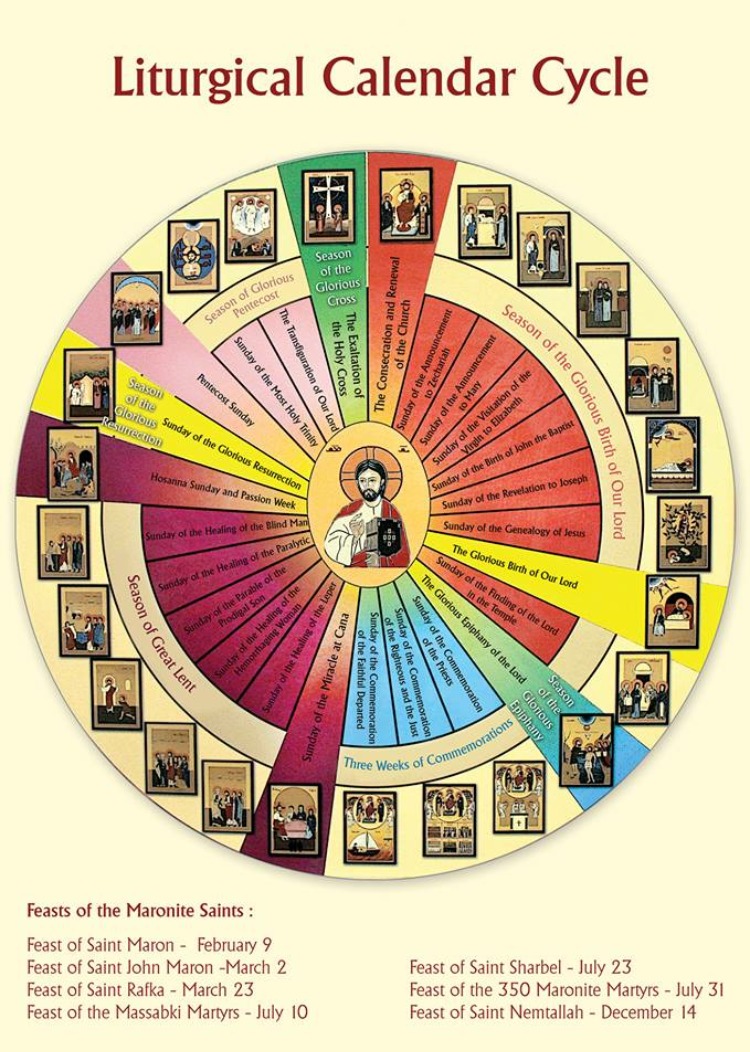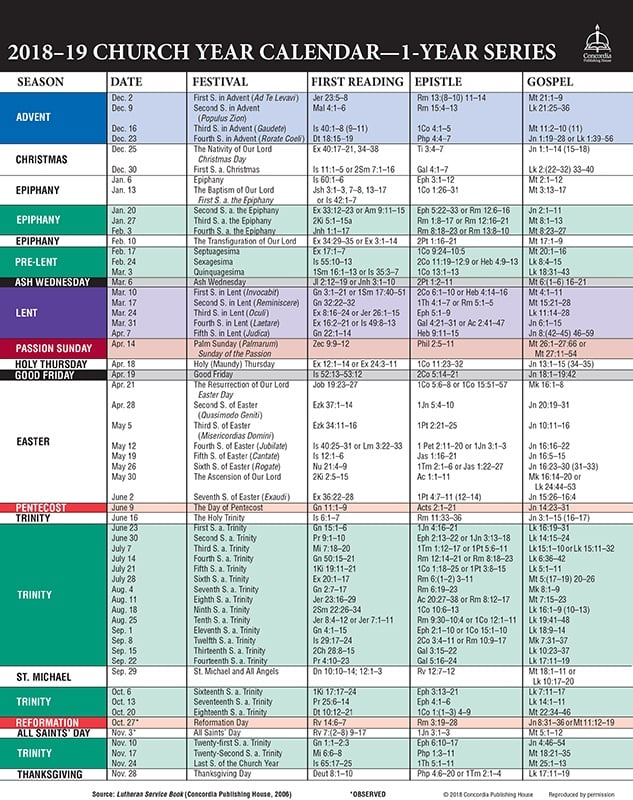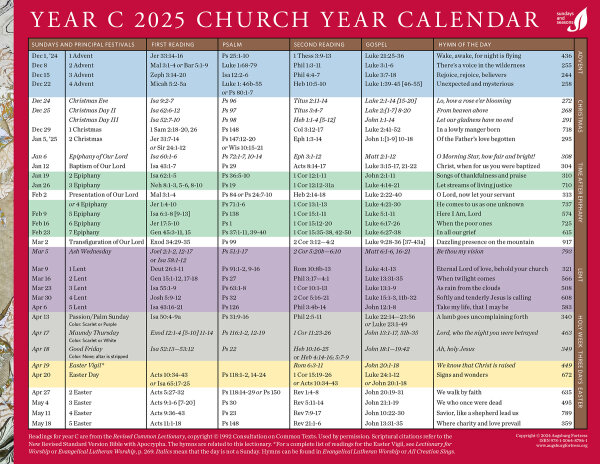Navigating the Hues of Religion: A Information to Lutheran Liturgical Calendar Colours in 2025
Associated Articles: Navigating the Hues of Religion: A Information to Lutheran Liturgical Calendar Colours in 2025
Introduction
On this auspicious event, we’re delighted to delve into the intriguing subject associated to Navigating the Hues of Religion: A Information to Lutheran Liturgical Calendar Colours in 2025. Let’s weave fascinating info and supply recent views to the readers.
Desk of Content material
Navigating the Hues of Religion: A Information to Lutheran Liturgical Calendar Colours in 2025

The Lutheran liturgical calendar, a vibrant tapestry woven from scripture, custom, and the unfolding seasons, makes use of shade as a robust symbolic language to reinforce worship and deepen understanding. The colours aren’t merely ornamental; they converse to the theological themes of every season and particular feast days, guiding the congregation’s religious journey all year long. Whereas variations exist amongst Lutheran traditions, a typically accepted system prevails, providing a constant framework for understanding the that means behind the vestments, paraments, and altar cloths. This text explores the liturgical calendar colours for 2025 inside this framework, offering a complete information to their significance and utility.
The Core Colours and Their Meanings:
The Lutheran liturgical calendar primarily employs 5 core colours, every carrying wealthy theological weight:
-
Inexperienced: That is the colour of Bizarre Time, the longest season within the liturgical 12 months. Inexperienced symbolizes development, life, and the continued work of God on the earth. It speaks to the on a regular basis faithfulness and the continual journey of discipleship. Throughout Bizarre Time, the main focus is on the teachings of Jesus and the unfolding of God’s plan of salvation. In 2025, Bizarre Time spans the weeks between Epiphany and Lent, and once more after Pentecost.
-
Purple/Violet: Representing penitence, humility, and contemplation, purple is the colour of Lent and Introduction. These seasons are occasions of preparation – Lent getting ready for Easter, and Introduction getting ready for Christmas. Purple encourages introspection, self-examination, and a deepening of religion as we await the approaching of Christ. The darker hue displays the somber but hopeful anticipation of those seasons. Some Lutheran church buildings may use a deep blue, which carries related connotations.
-
White/Gold: White (or its regal counterpart, gold) signifies purity, pleasure, victory, and glory. It’s the shade of Christmas, Easter, Ascension, Pentecost, and different main feasts celebrating the triumph of Christ and the work of the Holy Spirit. White represents the sunshine of Christ overcoming darkness, the purity of God’s grace, and the enjoyment of salvation. Gold provides a layer of splendor and divine glory.
-
Purple: Purple symbolizes the blood of Christ, martyrdom, the Holy Spirit, and the hearth of the Holy Spirit. It’s used on Pentecost Sunday, celebrating the descent of the Holy Spirit, and on days commemorating martyrs, whose lives got as a witness to the religion. Purple additionally represents the highly effective and transformative work of God.
-
Rose: A much less frequent however vital shade, rose is used on the Third Sunday of Introduction (Gaudete Sunday) and the Fourth Sunday of Lent (Laetare Sunday). Rose signifies pleasure and hope amidst the penitential seasons. It serves as a reminder that even in occasions of preparation and reflection, there may be trigger for rejoicing within the coming of Christ.
The 2025 Lutheran Liturgical Calendar and Shade Utility:
Making use of these colours to the 2025 liturgical calendar requires understanding the particular dates and observances. Whereas the precise dates fluctuate barely relying on the calculation technique used, the next gives a basic guideline:
Introduction (Purple/Violet): The season of Introduction in 2025 begins on Sunday, November thirtieth, and continues till Christmas Eve. All Sundays and weekdays throughout this era would usually be celebrated utilizing purple or violet vestments. The Third Sunday of Introduction (Gaudete Sunday) would make the most of rose.
Christmas (White/Gold): Christmas Day (December twenty fifth) and the twelve days of Christmas (till Epiphany) could be celebrated with white or gold.
Epiphany (White/Gold): Epiphany, celebrating the manifestation of Christ to the Gentiles, normally falls on January sixth, and is well known in white or gold. The Sundays following Epiphany till Ash Wednesday are celebrated in inexperienced.
Lent (Purple/Violet): Lent in 2025 begins on Ash Wednesday, February twenty sixth, and continues for six weeks till Holy Week. Purple or violet is the dominant shade all through Lent. The Fourth Sunday of Lent (Laetare Sunday) could be celebrated in rose.
Holy Week (Purple/Violet then White/Gold): Holy Week, main as much as Easter, usually maintains the purple/violet theme till Maundy Thursday. Good Friday typically makes use of a darker purple and even black in some traditions, signifying mourning. Easter Sunday is well known in white or gold.
Easter Season (White/Gold): The Easter season, extending for 50 days till Pentecost, is well known in white or gold. This signifies the victory of Christ over dying and the enjoyment of resurrection.
Ascension (White/Gold): Ascension Day, celebrating Christ’s ascension into heaven, is well known in white or gold.
Pentecost (Purple): Pentecost Sunday, commemorating the descent of the Holy Spirit, is well known in pink.
Trinity Sunday (White/Gold): Trinity Sunday, celebrating the Holy Trinity, is usually celebrated in white or gold.
Bizarre Time (Inexperienced): The durations between these vital seasons are noticed in inexperienced, symbolizing the continued life of religion and the continual work of God on the earth.
Variations and Concerns:
It is essential to do not forget that the particular utility of liturgical colours can fluctuate barely amongst completely different Lutheran denominations and even particular person congregations. Some church buildings would possibly use variations of the core colours, akin to a lighter purple or a deeper blue. The selection of material and the gildings on the vestments also can contribute to the general aesthetic and theological message. Moreover, using shade could also be influenced by native traditions and cultural contexts.
Past the Colours: The Deeper Which means:
Whereas the colours themselves are vital, their true energy lies of their integration with the liturgical texts, hymns, and total worship expertise. The colours function a visible help, guiding the congregation’s understanding of the theological themes of every season and feast day. They aren’t meant to be a inflexible system, however slightly a useful instrument to reinforce the religious journey of religion.
The liturgical calendar, with its wealthy tapestry of colours, is a robust reminder of the cyclical nature of religion, the continued work of God, and the ever-present hope provided by way of Jesus Christ. By understanding the importance of the colours utilized in 2025, Lutheran congregations can deepen their engagement with the liturgical 12 months and expertise a extra profound connection to the divine narrative unfolding all year long. The colours aren’t merely decorations, however slightly visible cues that time in the direction of the deeper mysteries of religion, inviting us to mirror, repent, rejoice, and in the end, to stay extra totally into the lifetime of Christ.








Closure
Thus, we hope this text has supplied invaluable insights into Navigating the Hues of Religion: A Information to Lutheran Liturgical Calendar Colours in 2025. We thanks for taking the time to learn this text. See you in our subsequent article!